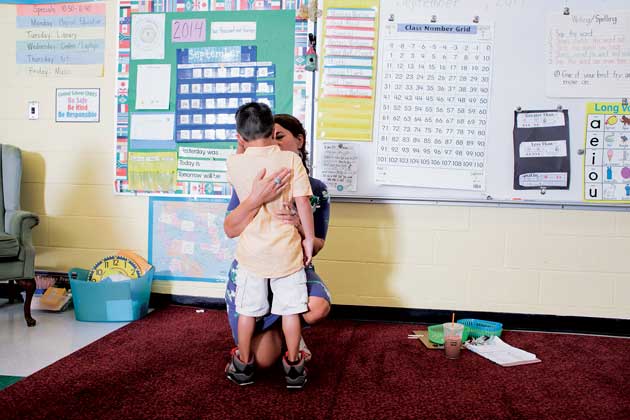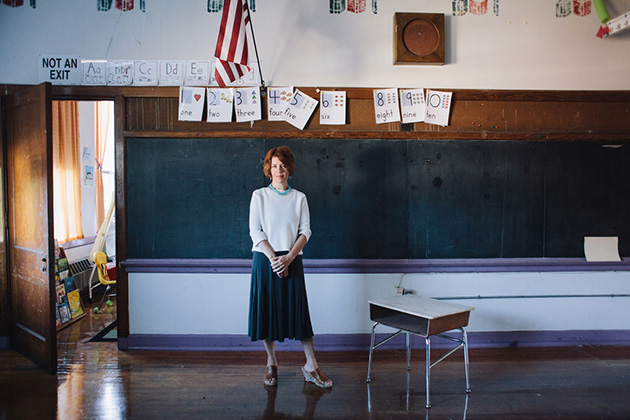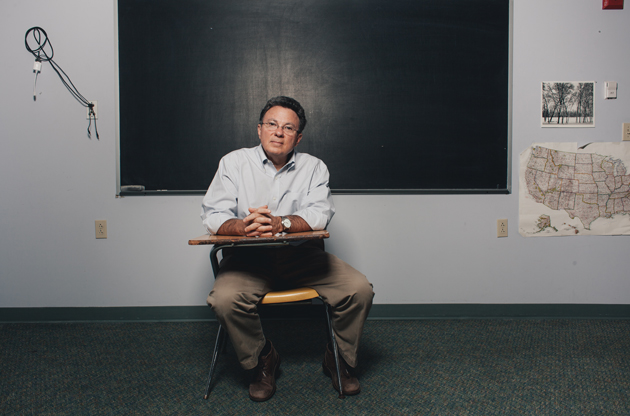
June Arbelo, a second-grade teacher at Central School, comforts a student who wants to go home during the first day of school. Tristan Spinski/GRAIN
Leigh Robinson was out for a lunchtime walk one brisk day during the spring of 2013 when a call came from the principal at her school. Will, a third-grader with a history of acting up in class, was flipping out on the playground. He'd taken off his belt and was flailing it around and grunting. The recess staff was worried he might hurt someone. Robinson, who was Will's educational aide, raced back to the schoolyard.
Will was "that kid." Every school has a few of them: that kid who's always getting into trouble, if not causing it. That kid who can't stay in his seat and has angry outbursts and can make a teacher's life hell. That kid the other kids blame for a recess tussle. Will knew he was that kid too. Ever since first grade, he'd been coming to school anxious, defensive, and braced for the next confrontation with a classmate or teacher.

The expression "school-to-prison pipeline" was coined to describe how America's public schools fail kids like Will. A first-grader whose unruly behavior goes uncorrected can become the fifth-grader with multiple suspensions, the eighth-grader who self-medicates, the high school dropout, and the 17-year-old convict. Yet even though today's teachers are trained to be sensitive to "social-emotional development" and schools are committed to mainstreaming children with cognitive or developmental issues into regular classrooms, those advances in psychology often go out the window once a difficult kid starts acting out. Teachers and administrators still rely overwhelmingly on outdated systems of reward and punishment, using everything from red-yellow-green cards, behavior charts, and prizes to suspensions and expulsions.
How we deal with the most challenging kids remains rooted in B.F. Skinner's mid-20th-century philosophy that human behavior is determined by consequences and bad behavior must be punished. (Pavlov figured it out first, with dogs.) During the 2011-12 school year, the US Department of Education counted 130,000 expulsions and roughly 7 million suspensions among 49 million K-12 students—one for every seven kids. The most recent estimates suggest there are also a quarter-million instances of corporal punishment in US schools every year.
But consequences have consequences. Contemporary psychological studies suggest that, far from resolving children's behavior problems, these standard disciplinary methods often exacerbate them. They sacrifice long-term goals (student behavior improving for good) for short-term gain—momentary peace in the classroom.
Teachers who aim to control students' behavior—rather than helping them control it themselves—undermine the very elements that are essential for motivation: autonomy, a sense of competence, and a capacity to relate to others.
University of Rochester psychologist Ed Deci, for example, found that teachers who aim to control students' behavior—rather than helping them control it themselves—undermine the very elements that are essential for motivation: autonomy, a sense of competence, and a capacity to relate to others. This, in turn, means they have a harder time learning self-control, an essential skill for long-term success. Stanford University's Carol Dweck, a developmental and social psychologist, has demonstrated that even rewards—gold stars and the like—can erode children's motivation and performance by shifting the focus to what the teacher thinks, rather than the intrinsic rewards of learning.
In a 2011 study that tracked nearly 1 million schoolchildren over six years, researchers at Texas A&M University found that kids suspended or expelled for minor offenses—from small-time scuffles to using phones or making out—were three times as likely as their peers to have contact with the juvenile justice system within a year of the punishment. (Black kids were 31 percent more likely than white or Latino kids to be punished for similar rule violations.) Kids with diagnosed behavior problems such as oppositional defiant disorder (ODD), attention-deficit/hyperactivity disorder (ADHD), and reactive attachment disorder—in which very young children, often as a result of trauma, are unable to relate appropriately to others—were the most likely to be disciplined.
Which begs the question: Does it make sense to impose the harshest treatments on the most challenging kids? And are we treating chronically misbehaving children as though they don't want to behave, when in many cases they simply can't?
That might sound like the kind of question your mom dismissed as making excuses. But it's actually at the core of some remarkable research that is starting to revolutionize discipline from juvenile jails to elementary schools. Psychologist Ross Greene, who has taught at Harvard and Virginia Tech, has developed a near cult following among parents and educators who deal with challenging children. What Richard Ferber's sleep-training method meant to parents desperate for an easy bedtime, Greene's disciplinary method has been for parents of kids with behavior problems, who often pass around copies of his books, The Explosive Child and Lost at School, as though they were holy writ.
His model was honed in children's psychiatric clinics and battle-tested in state juvenile facilities, and in 2006 it formally made its way into a smattering of public and private schools. The results thus far have been dramatic, with schools reporting drops as great as 80 percent in disciplinary referrals, suspensions, and incidents of peer aggression. "We know if we keep doing what isn't working for those kids, we lose them," Greene told me. "Eventually there's this whole population of kids we refer to as overcorrected, overdirected, and overpunished. Anyone who works with kids who are behaviorally challenging knows these kids: They've habituated to punishment."
"We know if we keep doing what isn't working for those kids, we lose them… Anyone who works with kids who are behaviorally challenging knows these kids: They've habituated to punishment."
Under Greene's philosophy, you'd no more punish a child for yelling out in class or jumping out of his seat repeatedly than you would if he bombed a spelling test. You'd talk with the kid to figure out the reasons for the outburst (was he worried he would forget what he wanted to say?), then brainstorm alternative strategies for the next time he felt that way. The goal is to get to the root of the problem, not to discipline a kid for the way his brain is wired.
"This approach really captures a couple of the main themes that are appearing in the literature with increasing frequency," says Russell Skiba, a psychology professor and director of the Equity Project at Indiana University. He explains that focusing on problem solving instead of punishment is now seen as key to successful discipline.
If Greene's approach is correct, then the educators who continue to argue over the appropriate balance of incentives and consequences may be debating the wrong thing entirely. After all, what good does it do to punish a child who literally hasn't yet acquired the brain functions required to control his behavior?

Nina D'Aran, the principal of Central School in South Berwick, Maine, has implemented many of Dr. Ross Greene's methods and philosophy along with her staff. Tristan Spinski/GRAIN
Will was still wielding the belt when Leigh Robinson arrived, winded, at the Central School playground. A tall, lean woman who keeps her long brown hair tied back in a ponytail, she conveys a sense of unhurried comfort. Central, which goes from pre-kindergarten through third grade, is one of a few hundred schools around the country giving Greene's approach a test run—in this case with help from a $10,000 state anti-delinquency grant.
Will, who started first grade the year Central began implementing Greene's program (known as Collaborative and Proactive Solutions, or CPS), was an active kid, bright and articulate, who loved to play outside. But he also struggled, far more than the typical six-year-old, to stay in his seat—or in the room. When he couldn't find words for what was bothering him, he might swing his hands at classmates or resort to grunting and moaning and rolling on the floor. A psychologist diagnosed him with a nonverbal learning disorder, a condition that makes it hard to adapt to new situations, transition between settings, interpret social cues, and orient yourself in space and time. At the beginning of second grade, Central designated Robinson as his aide.
Out on the playground, she approached the boy reassuringly, like a trained hostage negotiator. "Do whatever you need with the belt," she told him gently. "Just keep it away from people." Slowly, Will began to calm down. They walked over to some woods near the school, and she let him throw rocks into a stream, scream, and yell until, at last, he burst into tears in her arms. Then they talked and came up with a plan. The next time he felt frustrated or overwhelmed, Will would tell another staffer that he needed his helper. If Robinson were off campus, they would get her on the phone for him.
A few years earlier, staffers at Central might have responded differently, sending Will to the office or docking his recess time. In a more typical school, a kid who seems to be threatening others might be physically restrained, segregated into a special-ed room, or sent home for the day. Children with learning and behavior disabilities are suspended at about twice the rate of their peers and incarcerated at nearly three times the rate of the overall youth population, government data shows. Will, like most of Central's student body, is white, but for black kids with disabilities the suspension rate is 25 percent—more than 1 in 4 African American boys and 1 in 5 African American girls with disabilities will be suspended in a given school year.
Before Greene's program was put in place, conventional discipline at Central was the norm. During the 2009-10 school year, kids were referred to the principal's office for discipline 146 times, and two were suspended. Two years later, the number of referrals was down to 45, with zero suspensions, all thanks to focusing more on "meeting the child's needs and solving problems instead of controlling behavior," principal Nina D'Aran told me. "That's a big shift."
The CPS method hinges on training school (or prison or psych clinic) staff to nurture strong relationships—especially with the most disruptive kids—and to give kids a central role in solving their own problems. For instance, a teacher might see a challenging child dawdling on a worksheet and assume he's being defiant, when in fact the kid is just hungry. A snack solves the problem. Before CPS, "we spent a lot of time trying to diagnose children by talking to each other," D'Aran says. "Now we're talking to the child and really believing the child when they say what the problems are."
Before CPS, "we spent a lot of time trying to diagnose children by talking to each other," D'Aran says. "Now we're talking to the child and really believing the child when they say what the problems are."
The next step is to identify each student's challenges—transitioning from recess to class, keeping his hands to himself, sitting with the group—and tackle them one at a time. For example, a child might act out because he felt that too many people were "looking at him in the circle." The solution? "He might come up with the idea of sitting in the back of the room and listening," D'Aran says. The teachers and the student would come up with a plan to slowly get him more involved.
This all requires a dramatic change in mindset and workflow. Central School diverted building improvement funds to divide one classroom into two spaces. One side was called the "Learning Center"—a quiet spot for kids to take a break, maybe have a snack, and problem solve before going back into the classroom. The other area became a resource room. The school also committed to 20 weeks of teacher training, with an hour of coaching each week from Greene's trainer via Skype.
Will's breakthrough session happened in first grade, after several failed attempts, when D'Aran, then a guidance counselor, and his teacher sat down with him. He'd been refusing to participate in writing lessons with his classmates. Over 45 minutes, they coaxed Will through the initial moans and "I don't knows" and finally landed on a solution: Will said if he could use lined paper that also had a space to draw a picture, it would be easier to get started writing. Before long, he was tackling writing assignments without a problem.

Psychologist Ross Greene offers a radically different approach to fixing kids' behavior. Tristan Spinski/GRAIN
Greene, 57, has curly brown hair, glasses, and the habit of speaking in complete paragraphs, as though he's lecturing a psychology class instead of having a conversation. At the annual conference of Lives in the Balance, the nonprofit he founded to promote his method and advocate for behaviorally challenging kids, I watched him address a crowd of around 500 teachers, psychologists, and other professionals. His baby face and tweedy blazer called to mind a high school social-studies teacher, but he worked up a full head of steam as he spoke of millions of kids being medicated and punished for misbehavior.
The children at risk of falling into the school-to-prison pipeline, Greene says, include not only the 5.2 million with ADHD, the 5 million with a learning disability, and the 2.2 million with anxiety disorders, but also the 16 million who have experienced repeated trauma or abuse, the 1.4 million with depression, the 1.2 million on the autism spectrum, and the 1.2 million who are homeless. "Behaviorally challenging kids are still poorly understood and are still being treated in ways that are adversarial, reactive, punitive, unilateral, ineffective, counterproductive," he told the audience. "Not only are we not helping, we are going about doing things in ways that make things worse. Then what you have to show for it is a whole lot of alienated, hopeless, sometimes aggressive, sometimes violent kids."
Greene was trained in behavior modification techniques—a.k.a. the Skinner method—as are most people who work with families and children. But in his early clinical work as a Virginia Tech graduate student, he began to question the approach. He'd get parents to use consequences and rewards, but the families kept struggling mightily with the basics—from dressing to chores and bedtimes. To Greene, it felt like he was treating the symptoms while ignoring the disease.
Around the same time, he learned about new brain research by neuroscientists who were looking at brain functions with powerful fMRI machines. They found that the prefrontal cortex of our brains was instrumental in managing what is called executive function—our capacity to control impulses, prioritize tasks, and organize plans. Other research suggested that the prefrontal cortexes of aggressive children actually hadn't developed, or were developing more slowly, so that they simply did not yet have brains capable of helping them regulate their behavior.
But brains are changeable. Learning and repeated experiences can actually alter the physical structure of the brain, creating new neuronal pathways. Nobel laureate Eric Kandel found that memory may be stored in the synapses of our nervous system. He won the Nobel Prize in 2000 for studying the Aplysia, a very simple sea slug, and discovering that when it "learned" something, like fear, it created new neurons.
The implications of this new wave of science for teachers are profound: Children can actually reshape their brains when they learn and practice skills. What's more, Dweck and other researchers demonstrated that when students are told this is so, both their motivation and achievement levels leap forward. "It was all sitting there waiting to be woven together," Greene says. He began coaching parents to focus on building up their children's problem-solving skills. It seemed to work.
By the early 1990s, Greene had earned his Ph.D. in clinical psychology. He moved to Massachusetts, where he began teaching at Harvard Medical School and directing the cognitive-behavioral psychology program at Massachusetts General Hospital. He also began testing his new approach in children's psychiatric clinics that had previously used Skinneresque methods. In 2001, Cambridge Health Alliance, a Boston-area hospital group, implemented CPS, and reports that within a year, its use of physical and chemical restraints (like clonidine, which is a powerful sedative) in young patients dropped from 20 cases per month to zero. A subsequent five-year clinical trial at Virginia Tech involving 134 children aged 7 to 14 validated the method as an effective way to treat kids with oppositional defiant disorder.
By 2001, when The Explosive Child came out in paperback, Greene had become a sought-after speaker, even appearing on Oprah. The first peer-reviewed paper in a scientific journal validating the effectiveness of his model appeared in the Journal of Consulting and Clinical Psychology, and that led to even more invitations to speak at teaching hospitals and other facilities.

A child draws at Central School. Tristan Spinksi/GRAIN
In 2004, a psychologist from Long Creek Youth Development Center, a correctional center in South Portland, Maine, attended one of Greene's workshops in Portland and got his bosses to let him try CPS. Rodney Bouffard, then superintendent at the facility, remembers that some guards resisted at first, complaining about "that G-D-hugs-and-kisses approach." It wasn't hard to see why: Instead of restraining and isolating a kid who, say, flipped over a desk, staffers were now expected to talk with him about his frustrations. The staff began to ignore curses dropped in a classroom and would speak to the kid later, in private, so as not to challenge him in front of his peers.
But remarkably, the relationships changed. Kids began to see the staff as their allies, and the staff no longer felt like their adversaries. The violent outbursts waned. There were fewer disciplinary write-ups and fewer injuries to kids or staff. And once they got out, the kids were far better at not getting locked up again: Long Creek's one-year recidivism rate plummeted from 75 percent in 1999 to 33 percent in 2012. "The senior staff that resisted us the most," Bouffard told me, "would come back to me and say, 'I wish we had done this sooner. I don't have the bruises, my muscles aren't strained from wrestling, and I really feel I accomplished something.'"
"Is giving him a consequence—suspending him, calling his grandparents—is that going to teach him not to throw chairs?" she asks. "When you start doing all these consequences, they're going to dig their heels in even deeper, and nobody is going to win."
Maine's second juvenile detention facility, Mountain View, also adopted Greene's method, with similar results. Incidents that resulted in injury, confinement, or restraint dropped nearly two-thirds between April 2004 and April 2008.
Like the Long creek guards, staffers at Central were skeptical at first. When an enraged second-grader threw a chair at educational technician Susan Forsley one day, her first instinct was to not let him "get away with it." But she swallowed her pride and left the room until the boy calmed down. Later, she sat down with him and Principal D'Aran, and they resolved that if he felt himself getting angry like that again, he would head for the guidance office, where he'd sit with stuffed animals or a favorite book to calm down. Forsley eventually learned to read his emotions and head off problems by suggesting he take a break. "Is giving him a consequence—suspending him, calling his grandparents—is that going to teach him not to throw chairs?" she asks. "When you start doing all these consequences, they're going to dig their heels in even deeper, and nobody is going to win."
Will had graduated from Central and outgrown most of his baby fat when I arrived for breakfast at his home one Saturday morning. As he and his brothers helped prepare apple pancakes and fruit salad, he took a break to show me "Antlandia," a board game he created to showcase his knowledge of insects. Now in fifth grade, he'd made friends at his new school and was proudly riding the bus—something he couldn't handle before.
Between bites, Will consented to describe his experiences with the teachers and staff at Central School. "When they notice a kid that's angry, they try to help. They ask what's bothering them," he said, spiky brown bangs covering his eyebrows as he looked down at his plate. His mom, Rachel Wakefield, told me later that CPS had trained Will to be able to talk about frustrating situations and advocate for himself. Now, she said, he actually had an easier time of it than his big brother. "It's a really important skill as they enter into adolescence," she said.
From Greene's perspective, that's the big win—not just to fix kids' behavior problems, but to set them up for success on their own. Too many educators, he believes, fixate on a child's problems outside of school walls—a turbulent home, a violent neighborhood—rather than focus on the difference the school can make. "Whatever he's going home to, you can do the kid a heck of a lot of good six hours a day, five days a week, nine months a year," Greene says. "We tie our hands behind our backs when we focus primarily on things about which we can do nothing."
 Must-reads.
Must-reads. Declining costs for renewable energy like wind and solar give some climate scientists optimism that society can move to net-zero emissions by 2050.
Declining costs for renewable energy like wind and solar give some climate scientists optimism that society can move to net-zero emissions by 2050.







